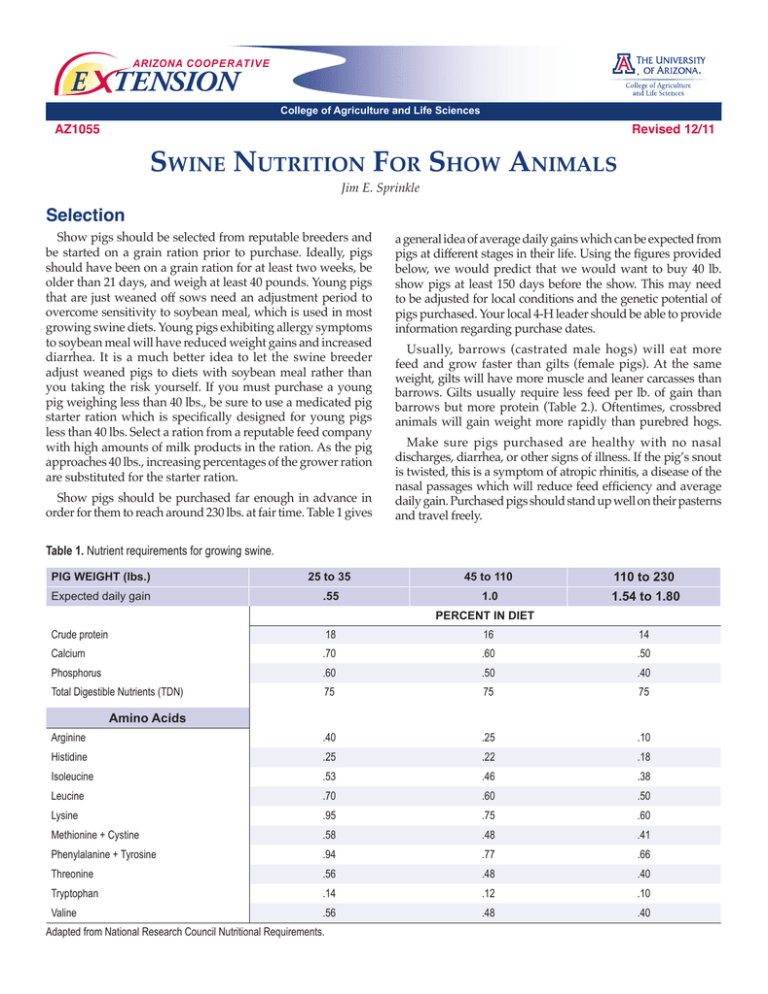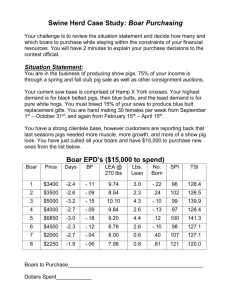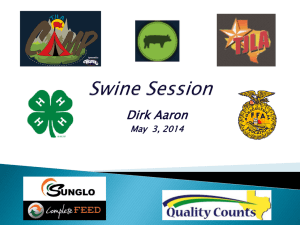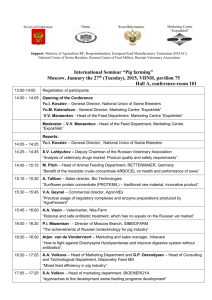S n F A
advertisement

ARIZONA COOP E R AT I V E E TENSION College of Agriculture and Life Sciences AZ1055 Swine Nutrition For Show Animals Revised 12/11 Jim E. Sprinkle Selection Show pigs should be selected from reputable breeders and be started on a grain ration prior to purchase. Ideally, pigs should have been on a grain ration for at least two weeks, be older than 21 days, and weigh at least 40 pounds. Young pigs that are just weaned off sows need an adjustment period to overcome sensitivity to soybean meal, which is used in most growing swine diets. Young pigs exhibiting allergy symptoms to soybean meal will have reduced weight gains and increased diarrhea. It is a much better idea to let the swine breeder adjust weaned pigs to diets with soybean meal rather than you taking the risk yourself. If you must purchase a young pig weighing less than 40 lbs., be sure to use a medicated pig starter ration which is specifically designed for young pigs less than 40 lbs. Select a ration from a reputable feed company with high amounts of milk products in the ration. As the pig approaches 40 lbs., increasing percentages of the grower ration are substituted for the starter ration. Show pigs should be purchased far enough in advance in order for them to reach around 230 lbs. at fair time. Table 1 gives a general idea of average daily gains which can be expected from pigs at different stages in their life. Using the figures provided below, we would predict that we would want to buy 40 lb. show pigs at least 150 days before the show. This may need to be adjusted for local conditions and the genetic potential of pigs purchased. Your local 4-H leader should be able to provide information regarding purchase dates. Usually, barrows (castrated male hogs) will eat more feed and grow faster than gilts (female pigs). At the same weight, gilts will have more muscle and leaner carcasses than barrows. Gilts usually require less feed per lb. of gain than barrows but more protein (Table 2.). Oftentimes, crossbred animals will gain weight more rapidly than purebred hogs. Make sure pigs purchased are healthy with no nasal discharges, diarrhea, or other signs of illness. If the pig’s snout is twisted, this is a symptom of atropic rhinitis, a disease of the nasal passages which will reduce feed efficiency and average daily gain. Purchased pigs should stand up well on their pasterns and travel freely. Table 1. Nutrient requirements for growing swine. PIG WEIGHT (lbs.) 25 to 35 45 to 110 110 to 230 Expected daily gain .55 1.0 1.54 to 1.80 Crude protein 18 16 14 Calcium .70 .60 .50 Phosphorus .60 .50 .40 Total Digestible Nutrients (TDN) 75 75 75 Arginine .40 .25 .10 Histidine .25 .22 .18 Isoleucine .53 .46 .38 Leucine .70 .60 .50 Lysine .95 .75 .60 Methionine + Cystine .58 .48 .41 Phenylalanine + Tyrosine .94 .77 .66 Threonine .56 .48 .40 Tryptophan .14 .12 .10 Valine .56 .48 .40 PERCENT IN DIET Amino Acids Adapted from National Research Council Nutritional Requirements. Feeding Unless your family has a swine operation with extensive background in formulating swine rations, complete commercial swine rations should be purchased. Complex amounts of vitamins, minerals, and amino acids must be provided in the complete diet. Feed mills can do a better job mixing these diets than someone without specialized equipment. Unlike ruminant animals, pigs are unable to manufacture essential amino acids and B vitamins by the means of microbes in the rumen. Amino acids are building blocks in the body which are used to make protein. There are 22 different amino acids used in making new protein in the muscle. Pigs can adequately synthesize 12 nonessential amino acids, but 10 essential amino acids must be provided in the diet. These essential amino acids are listed in Table 1. Grain rations are low in the lysine, threonine, tryptophan, and methionine amino acids. When grain is supplemented with soybean oil meal, amino acid requirements are usually met. Vitamins which are usually supplemented in swine diets include the fat soluble vitamins A, D, E, and K, and the B vitamins riboflavin, niacin, pantothenic acid, niacin, B12, and choline. Minerals commonly supplemented in swine rations include sodium chloride (salt), calcium, phosphorus, copper, iron, iodine, zinc, manganese, and selenium. Feed tags do not usually supply vitamin, mineral, and amino acid information. This type of information can be requested by your feed dealer from his supplier. The most economical way in which to feed your show pig is to feed different rations as the animal matures. As the animal matures, less protein needs to be fed. Protein is one of the more expensive components of feed, so protein is reduced in finishing rations. We commonly feed a grower rations until the pig weighs about 110 to 125 lbs. This is followed by a finishing ration until the animal is sold. Y our feed store should be able to provide swine growing and finishing rations. Rations should be fed ad lib which means the pig should be allowed to eat all he wants. Keep enough feed in the feeder to keep the pig satisfied while avoiding having so much feed in the feeder that spoilage occurs. Young pigs weighing 40 to 60 lbs. may eat as much as 5% of their body weight a day (3 lbs. of feed per day for a 60 lb. pig) while older market hogs weighing 200 lbs. may only eat 3% of their body weight per day (6 lbs. of feed per day). If your show animal is becoming too big and fat as the show approaches, you can do three things: (1) Impose some light exercise during the cool of the day (be sure not to stress the animal or get him breathing hard since swine cannot regulate body temperature by sweating) and (2) Reduce the energy or TDN content of the ration by substituting some of the complete ration with dehydrated alfalfa meal or small alfalfa pellets and (3) Take the hog off ad lib feeding by feeding 2.5 to 3% of body weight per day. Feed stores may have some alfalfa pellets for rabbits which you could substitute for some of the grain ration. The animal will be more content if you replace energy rich grain with some bulk (alfalfa) instead of just radically reducing the amount of daily ration fed. I recommend that initial substitutions of grain ration by alfalfa pellets be no more than 10 to 15%. If your hog appears that it may have trouble meeting sale weight, you can add calories to diet by giving the pig milk to drink in lieu of or in addition to water and you can add some type of fat to the diet such as corn oil. You will need to make sure the pig eats the grain with the added fat and that the feed doesn’t go rancid. A small portion can be added to each feeding and feed intake monitored. Fat is high in energy, containing 2.25 times more calories than protein or carbohydrates. To have the correct finish at fair time, hogs will need to weigh between 230 and 250 lbs. (depending on muscle) and have less than 1 inch backfat. You can monitor finish by looking at the Table 2. Nutritional requirements for swine. LEAN GROWTH RATE PIG WEIGHTS AT WHICH DIETS SHOULD BE FED (LBS.) Moderate 45 – 80 80 – 120 120 – 170 170 – 220 210 – 250 Nutrient Crude Protein (%)* 18 16 14 – 16 13 – 14 12 – 13 Lysine (%)* .95 .85 .72 – .82 .64 – .70 .56 – .60 Tryptophan (%)* .17 .15 .14 – .16 .12 – .13 .11 – .11 Threonine (%)* .64 .57 .50 – .57 .45 – .49 .39 – .42 Meth.+ Cystine (%)* .59 .53 .46 – .52 .41 – .45 .36 – .38 Calcium (%) .65 .60 .55 .50 .50 Avail.Phosphorus (%) .27 .23 .19 .18 .15 Riboflavin (mg/lb) 1.3 1.3 1.0 1.0 1.0 Niacin (mg/lb) 5 5 3.5 3.5 3 Panothenic Acid (mg/lb) 4 4 3.5 3.5 3 Vitamin B12 (microgram/lb) 5 5 2.5 2.5 2.5 *Lower figure is for barrows and higher figure for gilts. Adapted From Normal Req. from University of Illinois, July 23, 2001. Available at http://porknet.outreach.uiuc.edu. 2 The University of Arizona Cooperative Extension Figure 1. You can estimate weight for your hog using a sewing tape. Measure body length (BL) and heart girth (HG) in inches. Weight in lbs. = (HG x HG x BL)/400. If the hog weighs less than 150 lbs., add 7 lbs. to the final total. The body length is measured from the base of the tail to a point mid-point between the ears. You will have the best luck doing this if a feed pan is provided when you get the measurements. The heart girth is measured just behind the elbow. flank, brisket, jowl, over the loin, and between the hind legs. The loin should still have a roll to it and there should not be excessive fat down the centerline, around the tail head, between the hind legs, or in the jowl. As the hog gets bigger, it is important to monitor its weight gain to meet the sale target weight. If you do not have access to a scale, you can estimate weight using the guidelines shown in Figure 1. If you use any type of “repartitioning” (shifts weight gain predominantly to muscle gain) feed additive (Paylean®) for changing how weight is deposited, then extra care must be used to follow label directions. Paylean® should never be topdressed and should only to be used in a feed mill formulated ration when the hog weighs from 150 to 240 lbs. When using the product, the protein in the feed ration must be increased to at least 16% to accommodate the extra protein weight gain. Lysine in the ration must also be increased by 0.3%. With many show hogs, they are already genetically bred to be higher muscle show animals, so feeding Paylean® should be approached with caution. You do not want to produce a hog that fails to have adequate finish to provide a quality eating experience for the buyer. Furthermore, many leaner show hogs appear to be more prone to stress and making them leaner than they are genetically predisposed to be can create additional stress. Some rations, especially starter rations, include low levels of medication in the ration. These additive medicines have withdrawal periods specified by the U.S. government and can not be fed for periods as long as 14 days before slaughter. Make sure that there are no withdrawal times for rations which you are feeding your show pig during the final finishing period. For more guidelines on feeding Paylean®, please see the following fact sheet from Texas Cooperative Extension: http://animalscience.tamu.edu/images/pdf/nutrition/ nutrition-paylean-use-in-show-pigs.pdf ARIZONA COOP E R AT I V E E TENSION THE UNIVERSITY OF ARIZONA COLLEGE OF AGRICULTURE AND LIFE SCIENCES The University of Arizona College of Agriculture and Life Sciences Tucson, Arizona 85721 Jim Sprinkle Gila County Extension Director and Area Agent, Animal Sciences Contact: Jim Sprinkle sprinkle@cals.arizona.edu This information has been reviewed by University faculty. cals.arizona.edu/pubs/animal/az1055.pdf Originally published: 1998 Other titles from Arizona Cooperative Extension can be found at: cals.arizona.edu/pubs Any products, services or organizations that are mentioned, shown or indirectly implied in this publication do not imply endorsement by The University of Arizona. Issued in furtherance of Cooperative Extension work, acts of May 8 and June 30, 1914, in cooperation with the U.S. Department of Agriculture, Kirk A. Astroth, Interim Director, Cooperative Extension, College of Agriculture Life Sciences, The University of Arizona. The University of Arizona is an equal opportunity, affirmative action institution. The University does not discriminate on the basis of race, color, religion, sex, national origin, age, disability, veteran status, or sexual orientation in its programs and activities. The University of Arizona Cooperative Extension 3





